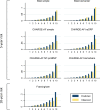Prediction of Atrial Fibrillation in a Racially Diverse Cohort: The Multi-Ethnic Study of Atherosclerosis (MESA)
- PMID: 26908413
- PMCID: PMC4802458
- DOI: 10.1161/JAHA.115.003077
Prediction of Atrial Fibrillation in a Racially Diverse Cohort: The Multi-Ethnic Study of Atherosclerosis (MESA)
Abstract
Background: Existing equations for prediction of atrial fibrillation (AF) have been developed and validated in white and African-American populations. Whether these models adequately predict AF in more racially and ethnically diverse populations is unknown.
Methods and results: We studied 6663 men and women 45 to 84 years of age without AF at baseline (2000-2002) enrolled in the Multi-Ethnic Study of Atherosclerosis (MESA). Of these, 38% were non-Hispanic whites, 28% non-Hispanic African Americans, 22% Hispanics, and 12% Chinese Americans. AF during follow-up was ascertained from hospitalization discharge codes through 2012. Information collected at baseline was used to calculate predicted 5-year risk of AF using the previously published simple CHARGE-AF model, which only includes clinical variables, and a biomarker-enriched CHARGE-AF model, which also considers levels of circulating N-terminal of the prohormone B-type natriuretic peptide and C-reactive protein. For comparison purposes, we also assessed performance of the 10-year Framingham AF model. During a mean follow-up of 10.2 years, 351 cases of AF were identified. The C-statistic of the CHARGE-AF models were 0.779 (95% CI, 0.744-0.814) for the simple model and 0.825 (95% CI, 0.791-0.860) for the biomarker-enriched model. Calibration was adequate in the biomarker-enriched model (χ(2)=7.9; P=0.55), but suboptimal in the simple model (χ(2)=25.6; P=0.002). In contrast, the 10-year Framingham score had a C-statistic (95% CI) of 0.746 (0.720-0.771) and showed poor calibration (χ(2)=57.4; P<0.0001).
Conclusion: The CHARGE-AF risk models adequately predicted 5-year AF risk in a large multiethnic cohort. These models could be useful to select high-risk individuals for AF screening programs or for primary prevention trials in diverse populations.
Keywords: atrial fibrillation; epidemiology; risk prediction.
© 2016 The Authors. Published on behalf of the American Heart Association, Inc., by Wiley Blackwell.
Figures

References
-
- Soliman EZ, Lopez FL, O'Neal WT, Chen LY, Bengtson L, Zhang ZM, Loehr L, Cushman M, Alonso A. Atrial fibrillation and risk of ST‐segment elevation versus non‐ST segment elevation myocardial infarction: the Atherosclerosis Risk in Communities (ARIC) Study. Circulation. 2015;131:1843–1850. - PMC - PubMed
-
- Van Wagoner DR, Piccini JP, Albert CM, Anderson ME, Benjamin EJ, Brundel B, Califf RM, Calkins H, Chen P‐S, Chiamvimonvat N, Darbar D, Eckhardt LL, Ellinor PT, Exner DV, Fogel RI, Gillis AM, Healey J, Hohnloser SH, Kamel H, Lathrop DA, Lip GYH, Mehra R, Narayan SM, Olgin J, Packer D, Peters NS, Roden DM, Ross HM, Sheldon R, Wehrens XHT. Progress toward the prevention and treatment of atrial fibrillation: a summary of the Heart Rhythm Society Research Forum on the Treatment and Prevention of Atrial Fibrillation, Washington, DC, December 9–10, 2013. Heart Rhythm. 2015;12:e5–e29. - PMC - PubMed
-
- Schnabel RB, Sullivan LM, Levy D, Pencina MJ, Massaro JM, D'Agostino RB Sr, Newton‐Cheh C, Yamamoto JF, Magnani JW, Tadros TM, Kannel WB, Wang TJ, Ellinor PT, Wolf PA, Vasan RS, Benjamin EJ. Development of a risk score for atrial fibrillation (Framingham Heart Study): a community‐based cohort study. Lancet. 2009;373:739–745. - PMC - PubMed
-
- Schnabel RB, Aspelund T, Li G, Sullivan LM, Suchy‐Dicey A, Harris TB, Pencina MJ, D'Agostino RB Sr, Levy D, Kannel WB, Wang TJ, Kronmal RA, Wolf PA, Burke GL, Launer LJ, Vasan RS, Psaty BM, Benjamin EJ, Gudnason V, Heckbert SR. Validation of an atrial fibrillation risk algorithm in whites and African‐Americans. Arch Intern Med. 2010;170:1909–1917. - PMC - PubMed
Publication types
MeSH terms
Substances
Grants and funding
- N01-HC-95162/HC/NHLBI NIH HHS/United States
- R01-HL-127659/HL/NHLBI NIH HHS/United States
- 16EIA26410001/AHA/American Heart Association-American Stroke Association/United States
- N01-HC-95159/HC/NHLBI NIH HHS/United States
- N01-HC-95165/HC/NHLBI NIH HHS/United States
- UL1-TR-000040/TR/NCATS NIH HHS/United States
- N01-HC-95160/HC/NHLBI NIH HHS/United States
- N01-HC-95161/HC/NHLBI NIH HHS/United States
- R01 HL127659/HL/NHLBI NIH HHS/United States
- N01-HC-95167/HC/NHLBI NIH HHS/United States
- N01-HC-95163/HC/NHLBI NIH HHS/United States
- N01-HC-95168/HC/NHLBI NIH HHS/United States
- N01-HC-95169/HC/NHLBI NIH HHS/United States
- N01-HC-95164/HC/NHLBI NIH HHS/United States
- UL1-TR-001079/TR/NCATS NIH HHS/United States
- N01-HC-95166/HC/NHLBI NIH HHS/United States
LinkOut - more resources
Full Text Sources
Other Literature Sources
Medical
Research Materials

